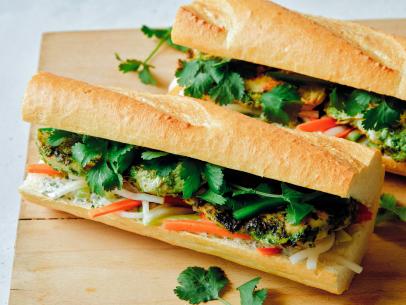
Bánh Cam
- Level: Intermediate
- Total: 2 hr 25 min (including cooling and resting times)
- Active: 1 hr 40 min
- Yield: 20 balls
-
- Nutritional Analysis
- Per Serving
- Serving Size
- 1 of 20 servings
- Calories
- 157
- Total Fat
- 4 g
- Saturated Fat
- 2 g
- Carbohydrates
- 27 g
- Dietary Fiber
- 2 g
- Sugar
- 9 g
- Protein
- 4 g
- Cholesterol
- 0 mg
- Sodium
- 109 mg
- Level: Intermediate
- Total: 2 hr 25 min (including cooling and resting times)
- Active: 1 hr 40 min
- Yield: 20 balls
-
- Nutritional Analysis
- Per Serving
- Serving Size
- 1 of 20 servings
- Calories
- 157
- Total Fat
- 4 g
- Saturated Fat
- 2 g
- Carbohydrates
- 27 g
- Dietary Fiber
- 2 g
- Sugar
- 9 g
- Protein
- 4 g
- Cholesterol
- 0 mg
- Sodium
- 109 mg
Ingredients
Sweet Mung Bean Filling:
Dough:
Directions
Special equipment:
a deep-fry thermometer- For the sweet mung bean filling: Place the mung beans in a fine-mesh strainer and rinse several times until the water runs clear. Transfer the mung beans to a medium saucepan and add enough water to cover the beans by 1 inch. Place several pieces of cheesecloth in the strainer (no need to clean it) to line it and set it aside.
- Bring the pot of mung beans to a boil over high heat, then reduce the heat so the beans just simmer. Cook, uncovered, stirring occasionally, until the beans are tender and easily mash between your fingers, 10 to 20 minutes; the time will depend on the brand and age of the beans you use.
- Strain the beans through the prepared cheesecloth-lined strainer and shake out any excess water. Add the beans back to the saucepan. Mash the beans until smooth with a potato masher, then stir in the sugar and 1/4 teaspoon salt. Cook on low heat until any excess liquid evaporates, 10 to 15 minutes, stirring constantly. Turn off the heat and stir in the coconut. Transfer the mixture to a medium bowl and cover the filling with a damp paper towel. Set the mixture aside until it is still warm but cool enough to handle, about 15 minutes.
- Lightly grease a work surface with vegetable oil and divide the mung bean mixture into 20 portions (about 1 heaping tablespoon each) and place on a parchment-lined baking sheet. Lightly grease your palms and roll each portion into a ball. Place in the freezer while you make the dough.
- For the dough: Whisk the glutinous rice flour, regular rice flour, potato starch, baking powder and 1/2 teaspoon salt together in a large bowl until evenly combined.
- In a 2-cup liquid measuring cup or a medium bowl, combine the hot water and sugar and whisk until the sugar is mostly dissolved. Whisk in the 2 teaspoons oil. Pour the liquid into the flour mixture and stir with a rubber spatula or wooden spoon until the mixture comes together to form a crumbly dough. Use your hands to knead the dough until it forms a smooth ball, adding additional hot water, 1 teaspoon at a time, if the dough is too dry. Continue to knead the dough for 2 minutes, then flatten into a disk that fits snugly in the bottom of the bowl. Place a piece of plastic wrap directly on the surface of the dough, pushing down the edges of the plastic wrap so that the dough is completely covered. Rest the dough at room temperature for at least 30 minutes and up to 2 hours.
- Line a baking sheet with parchment paper and set aside. Divide the rested dough in half. Roll the dough halves into two 8-inch logs, then cut each log into 10 pieces (for 20 portions total). Remove 4 balls of filling from the freezer and place on a plate close to where you are planning to form the bánh cam.
- Lightly grease your hands (including your fingers) with vegetable oil and flatten a dough portion in the palm of your hand until it’s a round roughly 3 inches wide. Place a filling ball in the center of the dough (cover the remaining dough balls with a damp towel to prevent them from drying out). While holding the filling against the dough with the index and middle fingers of your opposite hand, flip your hand over so that the dough is now on top of the filling. Use the thumb from your opposite hand to gently nudge the dough off of your palm (you will be able to press the dough back together if it tears a bit or becomes crumbly). The dough should naturally drape roughly over the filling. Use your fingers on both hands to gently push and press the dough so that it wraps completely around the filling, pinching together the seams so there are no gaps. Roll the ball in your palms until smooth. Place the rolled bánh cam onto the prepared baking sheet and cover loosely with a damp towel. Repeat with the remaining dough and filling.
- Pour the sesame seeds into a small bowl. One by one, roll the bánh cam in the sesame seeds until completely covered; gently press the seeds into the dough to ensure they stick during the frying process. Set aside.
- Pour enough vegetable oil into a Dutch oven to come 2 inches up the sides and heat the oil until it registers 340 degrees F on a deep-fry thermometer. Use a large slotted spoon or spider to lower 2 to 4 bánh cam into the oil and immediately use the spoon or spider to rotate the balls so that they stay off the bottom of the pot. Repeat to lower 2 to 4 additional bánh cam into the hot oil, depending on the size of the Dutch oven. Keep rotating the balls until they float to the top of the oil, around 2 minutes. Continue to cook, rotating often, until the bánh cam are nicely puffed and the sesame seeds are golden brown, 5 to 7 additional minutes. Transfer to a wire rack to drain. Repeat with the remaining balls. Transfer the bánh cam to a serving platter and serve warm or at room temperature.
Cook’s Note
Fried bánh cam can be kept at room temperature for up to 1 day. If you want to keep them longer you can refrigerate them for up to 5 days. The chilled bánh cam can be re-heated in the oven or in a toaster oven or air fryer until they are warmed through and crispy. Alternatively, you can freeze them on a baking sheet until they are solid, then transfer them to a resealable plastic storage bag and freeze for up to 3 months. Frozen bánh cam should be thawed before being re-heated.
Looking for Something Else?
Related Pages
- Mung Bean Thread Salad Recipe
- Sprouted Mung Bean Salad Recipe
- Mung Bean and Baby Basmati Risotto Flavored with...
- Moo Shu Style Vegetable Pancakes with Watercress...
- Mung Bean, Scallion and Pomegranate Salad Recipe
- Basic Glutinous Rice Recipe
- Pandan Waffles Recipe
- Ichigo Daifuku (Strawberry Mochi) Recipe
- Crispy Seaweed Snack Recipe































